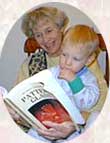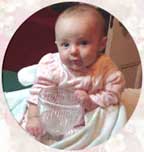--Educate yourself. If you haven't already, please start by reading What
Is EAPG?
Good reference books are a MUST if you intend to collect EAPG. Think
of them as “tuition” in your EAPG education. Another form of “tuition” is
all the glass mistakenly purchased which turns out NOT to be EAPG! Visit the PatternGlass.com
Book Store for some suggestions as to good books for beginners.
BEWARE: The Standard Encyclopedia
of Pressed Glass 1860-1930 by Edwards & Carwile 1999 contains hundreds
and hundreds of errors and should not be trusted for any information. This
applies also to their 2nd Edition. If you buy their 3rd Edition, you should
consider
getting counseling.- see
corrections.
--And of course the Pattern
Glass School on this web site is a continually expanding source
for information.
----Ask questions. Seek out experienced EAPG folks on-line, in print, or in
person at Glass shows.
--Think about how to structure your collection.
Do you want to collect a particular pattern?-- a particular color of
glass (custard, opaque, vaseline, etc.)? -- or do you want to collect
a specific form across all of the patterns
(for example a collection of wines in various patterns); or -- glass
from a particular factory.
-- And consider the space for a growing collection.
Do you need to think about collecting something small because there
is not room for many large pieces.
--The States’ series of glass has lovely small vases, wine glasses or
toothpick holders in most of the patterns and most of them can be found so
that it is reasonable to be able to grow the collection.
-- Children's glass was made in basic table services too, you can see a lot of it HERE. Mugs, shakers & toothpick holders are nice little things too.
If you are collecting something small like toothpick holders, there are rare
and uncommon ones that go for a great price, but until then, there are nice
ones to be had with relative ease and not much pain in your pocketbook.
--Bread trays are fun. Many are inexpensive, easy to display and have sayings
like "Waste not Want not" and are also reflective of the Victorian
tastes. Some are historical, like 1876 souvenirs, or presidential candidates,
etc. See some HERE.
--If you choose to collect something that is elegant, rare and expensive, you
may have to search long and hard and never realize the goal of having that
collection but if you are loaded and patient, this would be for you..
--Note characteristics such as size, shape, colors, presence/absence of a pontil,
pattern variations, etc. of the pieces or patterns you want to collect for
reference when you visit internet sites, shops, estate sales or shows.
--Avoid the malls and general antique shops for buying purposes, until you have built some confidence in
identifying and pricing the pieces you want to collect. These can be a trap
for the inexperienced, as many “generalist” antiques dealers are
well meaning but not qualified to correctly ID patterns or reproductions.
--When you buy in person examine carefully for chips and cracks. Cracks
are especially sneaky. Hold the glass up to the light and turn it around...the
cracks will sparkle out as silvery lines. Feel the edges for chips. Much old
glass has a "scratch" in the center or nearby, called a shear line,
or annealing mark or erroneously “straw mark”, which is not damage
but happened during the cooling process when the piece was made.
--Consider checking out Estate Sales… for one thing, the actual owners, or their agents, have a good chance of being able to affirm “age” of what they are selling because owners know their acquisition history and very often the glass sold there was handed down from past Family members. A handy way to find Estate Sales near you is to go to EstateSales.org
--Clarity & condition impact value in all glass. Make undamaged or very
minor damaged pieces your standard. The exception would be a case where you
can buy a piece for a “song” (see “tuition” above) for
study purposes. Nothing can take the place of touching and feeling the texture,
weight and “feel” of old glass.
-- Familiarize yourself with patterns and browse “real” antique stores
and lift pieces, rub your fingers over the rims and pattern to study the textures.
And always check for the tell-tale “wear” on the base. Even if a
piece has been boxed up for 80 years, if it is 100 years old, it was still
used for 20 years and that will be evident by wear on the base.
--Buy what you like. That way even if it's a mistake, you'll still be happy
to have it.
--Go where the good glass is; Museums, Public Libraries,
Glass Shows; Seek out the experts in the field for advice and consultation
- in print, on-line or in person at specialty shows. With the internet,
advice is abundantly available. The dealers listed on the Early
American Pattern Glass Society web site are always willing to help
when they are able. None of us claim to "know it all" but we are devoted
to the protection and preservation of this wonderful art form, and
are
always
seeking
to
develop knowledge
and awareness of its strengths and weaknesses, to insure its survival
as an enduring testament to our ancestor's' creativity, ingenuity and
love of beauty.
--Buying good antiques is considered to be a hedge
against inflation. EAPG is now from the century before last and the
good pieces will only increase in value as the years pass and more
and more of it is turned purple and essentially therefore taken off
the antiques market. But buy wisely- the better patterns in excellent
condition are always your best investment. |
|
Alert! It
has come to my attention that EAPG is being altered not only in color,
but is being engraved and ruby staining is being added and these
are very hard to distinguish from original decor. This underscores
once again the importance of knowing your source and dealing only
with knowledgeable sellers of EAPG.
Another
Alert! I
have been contacted by a student at Pattern Glass School to help
her ID
a very good piece of EAPG
she has. She was told by an "on-line appraisal service" that it
is a reproduction. For this she paid $10. But she had studied
well at Pattern Glass School and did not believe the appraisal and she was
right. Again,
nothing is as valuable as doing your own studying and trusting experienced
EAPG dealers.
--EAPG
was made in 2, 3, & 4 section molds. "Three mold" is meaningless
in determining the age of glass.
--Clear (colorless) EAPG is only valuable in its natural
colorless state. If it has turned purple, it has no value
as a historical piece of glass & while it might have intrinsic value
if it is a family piece, it is nothing more than a worthless curiosity. Read
more about it HERE.
--Many merchants do not know EAPG and will "create" pattern
names. As in many other situations, "trust but verify".
--Don’t decide to collect more of glass you have
inherited, until you are certain you have clearly identified the pattern
and the quality of the glass.
--Don't pay "book" price for a piece if you
are in doubt and the seller refuses to give you a written guarantee
of authenticity as to age & pattern.
--Don't get hung up on price guides, they should be used only in the most general
of ways. Buyers & sellers create the prices. Auction result catalogs can
be a great help because they reflect the actual market.
--Don’t buy from a seller who states "all sales final" anywhere
except at a clearance sale or table, flea market or yard sale & you can
afford to make a “blooper” purchase. The dealer is not interested
in the quality of his merchandise or reputation or in your satisfaction.
--Don't display glass in a window with strong, unfiltered
light for more than short periods of time. Abrupt changes in temperature
such as in a south facing window at sundown in the winter could cause a piece
to crack, if not shatter. Extended exposure to even indirect sunlight (ultraviolet
rays) could eventually cause the glass to take on a purple cast resulting
from a chemical reaction in the glass composition, greatly devaluing it.
--Never, never, never buy "sun-purpled" or irradiated glass! This
is ruined glass! If a dealer starts to tell you that it means the piece is
old, just walk away. A knowledgeable dealer knows other ways to tell age without
ruining the piece by turning it purple!!!! This is tantamount to smashing the
piece to prove it is glass- there are better ways.
--Don't store alcoholic beverages in bar bottles or decanters, and don't use
spooners, goblets and celeries for flower vases for more than a few hours!
They are gorgeous for show, but there can be a chemical reaction between glass
and alcohol, or even water, such that you can ruin your piece by making it
streaked, cloudy, aka "sick". See the Cleaning section
on this site.
--Shy away from the word "mint" in reference
to EAPG. Glass may be produced now in "mint" condition but most
pattern glass was made for the mass market and will have some bubbles or
other manufacturing defect. "Undamaged" is a term that describes
glass that has no chips, cracks, or other use or misuse-caused defects.
--Beware of reproductions. If in doubt, consult a book on reproductions or
ask someone you trust to know the difference. A couple of loose guidelines
are GENERALLY- reproductions
- are heavier than original issues
- have a slick or "oily" feel whereas old glass feels "dry" & sharp.
Having said that, there really are no hard & fast 'rules' that can be applied to all repros in every pattern.
Obviously one needs to have handled a lot of glass to be able
to make these distinctions.
Visit the beginnings of our Reproduction Site HERE.
--
Never put EAPG in a microwave and clear pattern glass may get cloudy if washed in a dishwasher.
|








